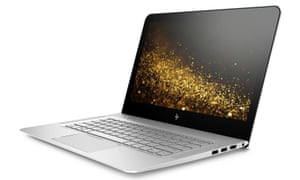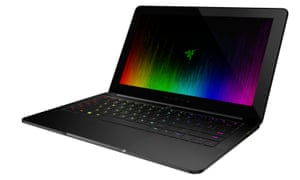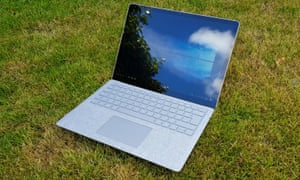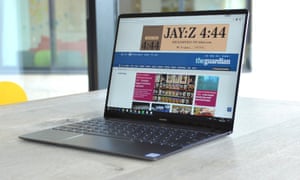What are the best MacBook Pro alternatives? | Technology
It used to be that if you wanted a premium, powerful but relatively small and light laptop, there weren’t many good options apart from Apple’s MacBook Pro. These days that certainly isn’t the case with loads of excellent options from the world of Windows 10 PCs.
With Apple’s new 13in MacBook Pro not being everyone’s cup of tea, here are some of the best 13in alternatives, all with high-resolution screens, seventh generation Intel Core i5 or i7 chips and power enough to do almost anything, perhaps even a little gaming.
Dell XPS 13

Price: from £1,149 (£1,429 as reviewed)
Since becoming a private company and separating from its enterprise arm, Dell has managed to shift itself from a work-machine dullard into a company that makes well designed computers â€" and the XPS 13 is probably the best.
Like most of the machines here, the XPS 13 has the latest seventh generation Intel Core i5 or i7 “U-series†processors, Intel HD620 or Iris Plus 640 graphics and your choice of 8 or 16GB of RAM and up to 1TB of SDD storage. But the best thing about the XPS13 is its so-called infinity screen, which has only small bezels at the top, left and right side.
It’s available in full HD, but it is the sharp, colourful and simply great QHD+ option that is the draw â€" it’s one of the best 13in screens available on any laptop at the moment.
The rest of the machine is well built. The XPS 13 is a metal and plastic sandwich. The lid and base are metal, the screen all glass and the deck a soft-touch black plastic, which does quite well at hiding the dirt and sweat-marks that usually build up with day-long typing.
The keyboard is good, but not excellent. The keys are well isolated, have good travel, they only have a little play, but are a bit on the small side. The trackpad is pretty good too.
Performance is excellent. The version with a Core i7 and HD620 graphics as tested was capable of blasting its way through anything from heavy photo editing to even a little bit of light gaming, capable of running XCOM 2 on low settings with the fans going flat out. (They are only just noticeable over the general hubbub of an open-plan office.)
The XPS 13 has two USB-A ports, an SD card reader, headphones socket and traditional power plug. But it also has a Thunderbolt 3 USB-C socket that can double as a charging port too, which means you can charge the Dell with either the included power adapter or any USB-C adapter that’s powerful enough.
Battery life was pretty good, lasting around 8 hours of relatively heavy use - enough for a full work day. There’s no Windows Hello camera or fingerprint scanner, which is slightly disappointing. The XPS 13 is pretty compact, but slightly thicker at its peak of 15mm than rivals and weighs 1.28kg.
Verdict: great all-rounder, with only minor niggles made up for by battery life and performance
HP Envy 13

Price: from £839 (£1,199 as tested)
The 13in HP Envy has the specifications to rival the best of the rest, including seventh-generation Intel Core i5 and i7 processors, but can be bought for significantly less money even with 1TB of SSD storage.
The QHD display has fairly large bezels, and isn’t quite as good looking as some of the other laptops at higher prices, but its touchscreen is good. The keyboard is OK, but it suffers from a bit of flex and isn’t the most comfortable to use, while the trackpad is accurate but a bit short.
Performance was about the same as the competition but it struggled a bit more with gaming and had a little more fan noise than the Dell XPS 13. The Envy 13 has plenty of ports on offer, with two USB-A ports, one USB-C, HDMI out, headphones socket and even a microSD card reader.
Battery life under relatively heavy office and image editing duties was about seven hours all in, while the only option for charging the Envy 13 is the included power adapter, which at least is quite small.
The one area where the Envy 13 is let down most is the build quality, which was spongey in some places on the desk, the lid and the bottom of the laptop. The finish isn’t quite the same as more premium rivals, and while it’s thin it’s also a little wider, deeper and heavier at 1.34kg.
Verdict: solid performer that undercuts the competition, but comes up short on fit and finish
Razer Blade Stealth

Price: from £1,349.99 (and as tested)
The Razer Blade Stealth is an interesting entry from gaming firm Razer. Part ultrabook, part gaming PC, the union of both produces something genuinely great.
Closed, its aluminium shell looks and feels premium. The 12.5in 4K model has a large green Razer logo on the lid and full-colour backlit keys as giveaways to its gaming heritage, but the new 13.3in QHD+ Stealth has the option to ensue all the colour for a more subtle grey detail and white keys making it feel more like a traditional ultrabook.
Packed with a seventh generation Core i7 processor, HD620 graphics and 16GB of RAM, the Blade Stealth is capable of handling most tasks and managed to outperform other laptops with similar specifications when gaming for extended periods. The fans are pretty eager to spin up and are rather high pitched but not particularly loud.
The keyboard is excellent, with good travel and well spaced keys making it comfortable to use, while the trackpad is also top class.
The Blade Stealth has a good array of ports with two USB-A ports, HDMI out, a headphones socket and a Thunderbolt 3 USB-C port, which doubles as the power socket. Unfortunately that means that unless you can daisy chain power through an adapter, anything that requires plugging into the USB-C port means you have to rely on battery power.
It lasted about 6.5 hours between charges under similar usage to the others in the group, which meant leaving the charger at home for a day of work wasn’t an option. The small and light USB-C charger makes carrying it a bit easier, but it’ll charge from most higher-powered USB-C chargers in a pinch.
There are a couple of screen options for the Stealth, including a 12.5in 4K version and a new 13.3in QHD screen that fits in the same sized body just with smaller bezels, which is a good thing as the 12.5in versions are a bit on the small side and have very large surrounds. The 4K version is crisp, as you might expect, bright, but the new 13.3in QHD version is likely to be the one to plump for.
Weighing 1.29kg the Stealth is on the lighter side of the group, and it’s only 13.1mm thick making it easy to cart around.

One thing that’s unique to the Razer Blade Stealth is the ability to use Razer’s external graphics card system called the Core. Hooked up to the Stealth via a Thunderbolt 3 cable, it’s capable of charging the laptop while boosting performance and connecting to several USB devices, ethernet and monitors.
With an AMD RX 480 graphics card in the Core, the Stealth was able to play XCOM 2 at 4K with medium details and run an Oculus Rift VR headset without issue, which was very impressive. It’s not cheap (£499 just for the Core), but it can turn the thin and light laptop into a desktop powerhouse with one cable.
Verdict: sleek and well made, with a bit of flare and excellent performance
Microsoft Surface Laptop

Price: from £979 (£1,249 as tested)
Microsoft’s first own-brand laptop, the Surface Laptop, is easily one of the best Windows 10 laptops available, but it isn’t without fault.
At 14.5mm thick it’s not too chunky, while it weighs 1.25kg which is about average. There’s nothing average about the design though, with a completely flat lid and mirrored Microsoft logo, alcantara-covered keyboard deck and minimalist base and port design, it stands out as a very new Microsoft product.
The keyboard is one of the best ever fitted to a laptop, while the trackpad is large and precise. The fabric covered deck is interesting and feels warmer and more comfortable on the heals of your palms during long typing sessions.
The 13.5in screen is beautiful, the performance is in-line with the competition thanks to its seventh-generation Core i5 or i7 and the battery lasts for around 10 hours, which makes it one of the longest-lasting machines with this level of power. The Windows Hello facial recognition works brilliantly logging you into Windows almost instantly.
It comes out of the box with Windows 10 S, which is a restricted version of Windows 10 that most will want to change. Upgrading to Windows 10 Pro is free until the end of the year, and is a five-minute job.
The only downside is the poor selection of ports. The Surface Laptop only has a Surface connector for power and attaching to an optional dock, one USB-A port, a miniDisplayPort and a headphones socket. There’s no USB-C or Thunderbolt, which is disappointing.
Verdict: long battery life, great keyboard and screen only let down by poor port selection
Huawei MateBook X

Price: from $1,099.99 (£851) and as tested
Huawei’s first laptop is one of the thinnest and lightest laptops available with the full-blooded seventh generation Intel Core i5 or i7 “U-series†processors but in a fanless design, making the MateBook X something a bit special.
That means there is no active cooling, just some clever phase-change materials underneath that dissipate heat without making a sound. Other fanless laptops such as the Apple MacBook are restricted to the less capable “Y-series†of Intel chips that aren’t quite in the same class. In contrast, the MateBook X â€" tested with a Core i5 processor and 8GB of RAM â€" is capable of handling everything from work duties, image editing and even a light bit of gaming.
The 12.5mm thick aluminium body, 1.05kg weight and minimalist design make for an easy to carry and attractive package and is easily the best-looking laptop in this group. The keyboard is also excellent, with solid travel and comfort, while the trackpad is good and responsive.
The screen with its slim bezels is beautiful, but isn’t a touchscreen, which is a bit of a shame. The speakers are some of the best I’ve listened to from a laptop: loud, clear and precise, but still lacking real bass.
It has two USB-C ports, but neither are Thunderbolt 3 compatible. The one on the left accepts power, while the one of the right side works with the included Huawei MateDock 2 dongle for additional USB-A, VGA, HDMI and USB-C passthrough. A headphone port sits next to the left USB-C port, while a fingerprint scanner built into the power button logs you into Windows instantly with a touch.
The MateBook X lasted just under seven hours during testing, which means you’ll be reaching for a plug before the end of a working day, but the included USB-C power adapter isn’t much bigger than a phone charger so is easy to carry.
Some models won’t come with a trusted platform module (TPM), which means encrypting your information with Windows BitLocker will be difficult, while there’s a little flex in the deck of the laptop at the top, which you won’t notice unless you go looking for it.
Verdict: a beautiful thin-and-light fanless laptop with all the power of a full machine

0 Response to "What are the best MacBook Pro alternatives? | Technology"
Posting Komentar